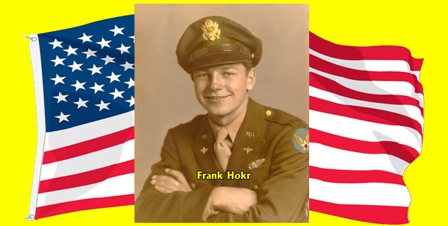|

PROFILE OF A MUSEUM
VOLUNTEER
FRANK
HOKR
Frank V. Hokr was born August 1, 1924 in
Cicero, a suburb of Chicago, Illinois. His parents, Frank and Rose, were
immigrants from Czechoslovakia, who had immigrated to the United States in
1918 just after the end of World War I.
Most of Frank's pre-school years were
spent with his aunt and uncle and he grew up first speaking only Czech. At the age of six, Frank's parents enrolled
him in the Shakespeare Branch Elementary School, where he began to learn how
to read, write and speak English for the first time. His family then moved to Indiana where
Frank attended the Pine Township Elementary School of Beverly Shores. After his sophomore year the family started
west and south along Route 66, settling in Los Angeles, California. Frank enrolled in Manual Arts High School
where his major was Electric Shop. The
emphasis was on Math and Science classes, especially physics and
chemistry. Frank graduated from high
school in the summer of 1941. Continuing
his education he enrolled at Los Angeles City College in two engineering
classes, Electrical and Radio engineering. This again meant more math
courses.
December 7, 1941, when the Japanese
attacked Pearl Harbor in Hawaii, it meant a whole new kind of world was about
to face young men around the world.
Frank was inducted into the Army December 8, 1942, one year after
Pearl Harbor. They were taken by train to Fresno, a small farming town,
located in Central California, where they were issued only the bare
basics. They all knew that
"YOU'RE IN THE ARMY NOW!"
When Frank completed Basic Training, he
was sent back to a real Army life at Santa Ana Army Air Base fondly
remembered as SAAAB. Through it all,
there was the continual experience of marching, marching, marching. It occurred to Frank that possibly they
were just going to walk over the Japanese and Germans!
Frank was shipped 15th of September 1943
to Santa Maria, California to train at the Alan Hancock School of Aviation,
Primary Flight School. He completed his last flight there on the 27th of
September, with 68.45 hours in his logbook.
The second phase began October 1st with basic Flight School, at
Marana, Arizona. Four days later, he was disappointedly washed out. Frank and about 60 or 70 other EP's
(eliminated pilots) traveled east to San Marcos, Texas (2356th AFB) for the Air Corps
Navigators School. Upon graduating as
a 2nd Lieutenant from Navigator School, and a leave home, Frank
reported to Lincoln, Nebraska at the Classification Center where he was
assigned to Combat Crew Training at Davis-Monthan
AFB, then to Newport News, Virginia. It was there they learned they had been
ordered to the 461st Bomb Group, 15th Air Force in Italy. Frank’s crew realized that this would be
the "Mother of All First Missions.”
Two hours into the mission the bomber
formations began to encounter their first flak of barrages. Their attacking fighters then immediately
hit them from two directions. Having
no other choice, they were forced to bail out of the aircraft. This was a sad
ending to his first bombing mission.
Frank was captured, interrogated at least five times and finally
interned in Stalag Luft
1, Barth, Germany. The day was December 30, 1944.
Stalag 1 was a POW camp,
detaining over 10,000 POW's. Frank and
his comrade’s liberation came with the arrival of Soviet Union troops. On June 11 they boarded the SS General
Buckner and arrived at Hampton Roads on the 20th of June 1945. Frank's last
stop was Camp Patrick Henry.
The war over and discharge eminent, an Air
Force recruiter persuaded Frank to retain his commission by joining the Air
Force Reserve. He began weekend flight training, and was reclassified as a
Bombardier-Navigator. Frank’s outfit
was combat ready when they learned that the North Koreans had just crossed
the 38th parallel. No more
weekend warrior status. His wing was consolidated with the 452nd Bomb Wing (L) and
within 60 days were flying their first combat missions. During that time, Frank flew 67 missions,
including providing air support for General McArthur’s Inchon Landing, and
close support to the Marines at the Chosin
Reservoir. His outfit also gave close
support for the British troops at Kuna-ri as well
as the Turks at Hagaru-ri. Upon completion of his
tour in Korea, he was reassigned to the 6163rd Air Base Wing at
Misawa, Japan.
In early August 1951, orders were cut to
return stateside and Frank was reassigned to the Air National Guard Unit at
Birmingham, Alabama. A month before
his discharge was scheduled, Korean veterans including Frank, were treated to
a two-week combat training session in Temple, Texas. Their schooling included night flights,
bombing range and gunnery practice, as well as ground school reviewing of the
Officer's Manual! At this point Frank
decided to opt out, resigned his reserve commission, and returned to his
civilian life.
Frank
became a commercial artist in the Los Angeles area. In August 1950, he married a Fresno native,
Lillian Maslowski who had attended Clovis High
School just northeast of the city.
They had three children and eventually were blessed with six
grandchildren. Frank became a business
partner in an Audio-Visual Production company in 1975, where he remained
until his retirement.
Frank
retired in August 1989, and in February 1990, he and Lillian moved from
Southern California to Fresno. Frank
is currently active with American Ex-POW Post No.1 in Fresno. He also serves
on the staff of the Legion of Valor Museum as an assistant to the Curator Ray
Lee. Frank enjoys his various
assignments while working with the friendly museum staff.
|